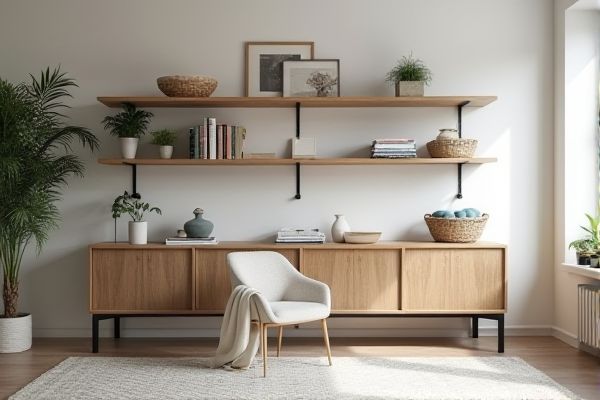
Freestanding shelving offers flexibility in placement and easy relocation, making it ideal for spaces where you want to change layouts frequently; wall-mounted shelving maximizes floor space and provides a sleek, permanent storage solution. Discover which option best suits Your needs and how to effectively utilize both types in the rest of this article.
Table of Comparison
| Feature | Freestanding Shelving | Wall-Mounted Shelving |
|---|---|---|
| Installation | No drilling required; easy to move | Requires drilling; fixed installation |
| Space Efficiency | Occupies floor space | Maximizes floor space |
| Weight Capacity | Supports heavy items without wall damage | Weight limit depends on wall type and anchors |
| Flexibility | Portable and reconfigurable | Permanent, less flexible |
| Design Options | Variety of sizes, materials, and styles | Modern, sleek designs but limited sizes |
| Maintenance | Easy to clean under and around | More difficult to clean behind |
| Cost | Generally lower initial cost | Potentially higher due to installation |
Introduction to Freestanding vs Wall-Mounted Shelving
Freestanding shelving offers versatile storage solutions with easy mobility and no wall installation, ideal for spaces requiring flexible organization. Wall-mounted shelving maximizes floor space, providing a sleek, permanent storage option anchored securely to walls for added stability. Choosing between these options depends on room layout, load capacity needs, and aesthetic preferences.
Defining Freestanding Shelving
Freestanding shelving is a versatile storage solution that stands independently without needing wall support, making it ideal for flexible room layouts and easy relocation. These units typically feature sturdy frames and multiple shelves designed to hold various items, from books to decorative pieces, providing practical organization in spaces where wall mounting is unfeasible. Your choice of freestanding shelving allows for customizable storage options tailored to your space constraints and aesthetic preferences.
Defining Wall-Mounted Shelving
Wall-mounted shelving consists of storage units affixed directly to walls, maximizing floor space and providing a sleek, modern look ideal for small or minimalist interiors. These shelves often support lightweight to medium loads, commonly used for books, decor, or kitchen essentials, with installation requiring sturdy wall anchors or studs for stability. Compared to freestanding shelving, wall-mounted options offer customizable heights and arrangements, enhancing room organization without occupying valuable floor area.
Space Utilization and Room Layout
Freestanding shelving offers flexibility in space utilization, allowing you to rearrange and optimize room layout without permanent installation, ideal for dynamic living or work environments. Wall-mounted shelving maximizes floor space by freeing up the area beneath, creating an open and airy room design, especially beneficial in smaller spaces. Your choice depends on how you prioritize mobility versus maximizing available square footage for efficient storage solutions.
Installation Complexity and Flexibility
Freestanding shelving offers simple installation with no need for wall modifications, providing maximum flexibility to rearrange or relocate units as needed. Wall-mounted shelving requires precise measurements, anchors, and tools for secure installation, resulting in a fixed placement that maximizes floor space but limits versatility. Choosing between the two depends on whether ease of setup or permanent, space-saving solutions are the priority.
Durability and Weight Capacity Comparisons
Freestanding shelving units often offer greater durability and higher weight capacity due to their robust frame and ability to distribute loads evenly across the floor. Wall-mounted shelving relies heavily on stud integrity and mounting hardware strength, limiting its weight capacity compared to freestanding options. Choosing between the two depends on specific storage needs, with freestanding shelves preferred for heavy or bulky items and wall-mounted shelves suited for lighter, space-saving applications.
Aesthetic and Design Considerations
Freestanding shelving offers versatile placement options and can serve as a striking focal point in various interior styles, enhancing room depth with its dimensional presence. Wall-mounted shelving provides a sleek, minimalist aesthetic that maximizes floor space and creates a clean, streamlined look ideal for small rooms or contemporary designs. Both options allow customization in materials, colors, and shapes, influencing the overall visual impact and complementing different decor themes.
Cost and Budget Analysis
Freestanding shelving typically involves lower upfront costs and greater flexibility in placement without installation fees, making it ideal for budget-conscious projects. Wall-mounted shelving may incur higher costs due to hardware, professional installation, and wall repairs but can save space and provide a sleeker look, potentially increasing property value. Consider your storage needs and space constraints when evaluating the total cost and long-term value of each option for your budget.
Best Use Cases for Each Shelving Type
Freestanding shelving is best suited for flexible storage needs, allowing you to easily rearrange or relocate shelves in spaces like garages, living rooms, or offices where mobility and accessibility are important. Wall-mounted shelving excels in maximizing floor space in small rooms, bathrooms, or kitchens, providing stable and secure storage for items you want to keep off the ground. Your choice depends on whether you prioritize portability and adaptability or permanent, space-saving solutions.
Conclusion: Choosing the Right Shelving Solution
Freestanding shelving offers flexibility and easy relocation, making it ideal for temporary or frequently changing spaces, while wall-mounted shelving maximizes floor space and provides a sleek, permanent storage solution. Consider the weight capacity needs, room layout, and aesthetic preferences to determine the best fit for your environment. Prioritize durability and installation requirements to ensure safety and long-term functionality when selecting between freestanding and wall-mounted options.
 homyna.com
homyna.com